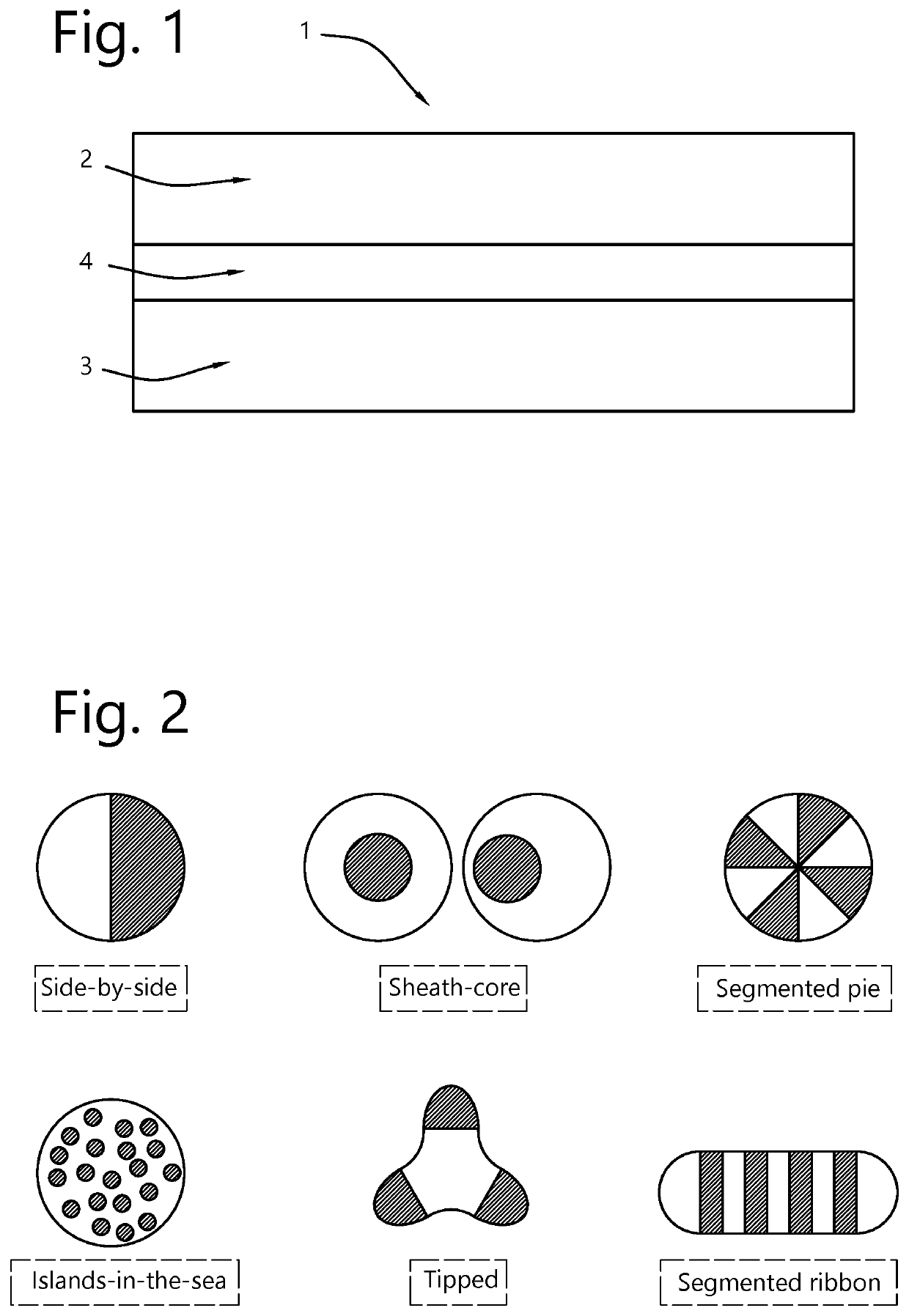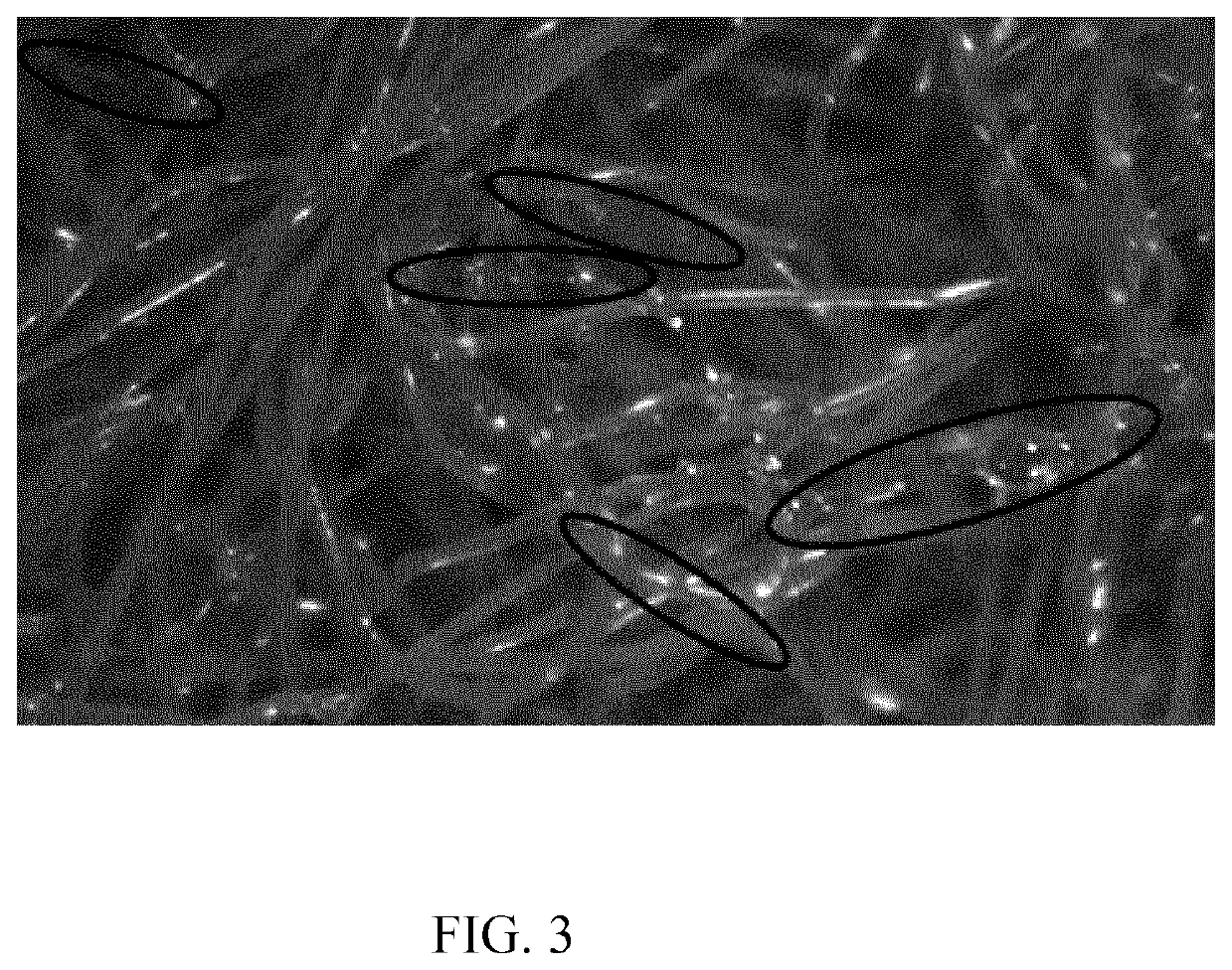Non-woven structure with fibers catalyzed by a metallocene catalyst
a metallocene catalyst and non-woven technology, applied in the direction of excavation, separation process, filtration separation, etc., can solve the problems of limited range of plastics that can be recycled, limited range of plastics, and inability to add recycled plastic materials to raw polymers without decreasing at least some quality attributes, etc., to achieve good coverage (ability to prevent see-through), high fiber-fiber friction, and good permeability.
- Summary
- Abstract
- Description
- Claims
- Application Information
AI Technical Summary
Benefits of technology
Problems solved by technology
Method used
Image
Examples
embodiment 1 (
Bicomponent Fibers)
[0135]This embodiment provides an entangled and bonded non-woven structure which relies on the use of staple fibers of which some or all are bicomponent fibers. A bicomponent fiber can be made of the second material such as a polyolefin, e.g. polypropylene, whereby on the surface of the bicomponent fibers there is exposed a first material different from the second material. There is a difference in melting point between the first material and the second material. For example the second material can be a conventional PP having a melting point of 160-165° C., while the first material is, for example a specific polyolefin. The first material is preferably a polyolefin, e.g. polypropylene produced with one or more catalysts wherein one of the catalysts is a metallocene catalyst. The melting point of the first material is selected to be lower than the second material, e.g. at least 10° C. lower. For example the melting point of the first material can be in the range of...
embodiment 2
[0153]This embodiment provides an entangled non-woven structure which relies on the use of staple fibers. A first staple fiber is made of a second material such as a polyolefin, e.g. polypropylene, and a first staple fiber is made of a first material such as a polyolefin, e.g. polypropylene. There is a difference in melting point between the first and second materials. For example the second material can be conventional PP having a melting point of 160-165° C., while the first material is, for example a specific polyolefin. The first material is preferably a polyolefin, e.g. polypropylene produced with one or more catalysts wherein one of the catalysts is a metallocene catalyst. The melting point of the first material is selected to be lower than the second material, e.g. at least 10° C. lower. For example the melting point of the first material can be in the range of 130-170° C. (or 130-155° C.).
[0154]The first fibers are bonded to the second fibers by a thermal pressureless bondin...
embodiment 3
Fiber Production:
[0156]Bicomponent fibers of sheath / core type with the core made of polypropylene (Polychim, PP HB12XF polypropylene with a melting point of 160° C. according to ISO 3146) and a sheath of polypropylene-based copolymer made with a metallocene catalyst (Total, Lumicene® MR10MX0 with a melting point of 140° C. according to ISO 3146). Two types of fibers were produced:
Type 1: 70% by weight in the core—30% by weight in the sheath
Type 2: 80% by weight in the core—20% by weight in the sheath.
[0157]Properties of the fibres produced are given below.
RatioThicknessTenacityElogationType 170 / 305.2 dtex32 cN / tex154%Type 280 / 205.2 dtex32 cN / tex161%
(Measurement of dtex according to ISO 1973)
Needlefelt
[0158]An event carpet was made of a needle punched nonwoven structure, which was made entirely out of bicomponent fibers. Thermal bonding was performed at an oven temperature of 145° C. (preferably by a thermal pressureless bonding process).
[0159]Needle punched nonwoven structure with T...
PUM
| Property | Measurement | Unit |
|---|---|---|
| melting point | aaaaa | aaaaa |
| melting point | aaaaa | aaaaa |
| temperature | aaaaa | aaaaa |
Abstract
Description
Claims
Application Information
 Login to View More
Login to View More - R&D
- Intellectual Property
- Life Sciences
- Materials
- Tech Scout
- Unparalleled Data Quality
- Higher Quality Content
- 60% Fewer Hallucinations
Browse by: Latest US Patents, China's latest patents, Technical Efficacy Thesaurus, Application Domain, Technology Topic, Popular Technical Reports.
© 2025 PatSnap. All rights reserved.Legal|Privacy policy|Modern Slavery Act Transparency Statement|Sitemap|About US| Contact US: help@patsnap.com


